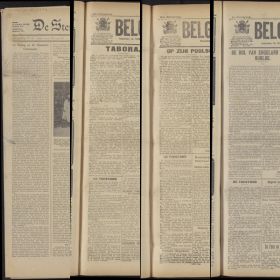In the First World War, the Dutch-Belgian border was not an ordinary national boundary. South of the border there was war, while to the north lay the peaceful, neutral Netherlands. The Germans army did not initially invest very heavily in the defence of this northern border, as an attack from the neutral Netherlands seemed unlikely.
The Germans did have some concerns, however; what if the Allied forces should choose to invade Belgium from Zeelandic Flanders? There was a chance that the Netherlands would then join the Allies. To prevent that, German military engineers designed a line of defensive works along the Dutch-Belgian border. Press-ganged Belgian labourers were put to work on its construction, and in the summer of 1917, a German defence line was built that ran from the Belgian coast to Turnhout.
Belgisch Dagblad on the 12th of February 1917: Reinforcements at the border
The line consisted of trenches, casemates, parapets and no less than 1,370 bunkers. Often more comfortable than others of their kind at the front, they were even tall enough to stand in. After all, the German engineers at the quiet Dutch-Belgian border had plenty of time to concentrate on comfort. But camouflage was equally important, as the bunkers should not be immediately recognisable to enemy reconnaissance aircraft. To that end, the smooth surfaces of their concrete walls were sometimes deliberately made coarse and uneven, allowing the bunkers to blend in with their natural environment and rendering them less visible from above.
The invasion from the Netherlands never came. The war ended without a single shot being fired on the kilometres long frontline, which was simply forgotten after the war. Most trenches have eroded or become overgrown, though some trench systems located in wooded areas have been less affected by the passage of time. Over ten kilometres worth of trenches were recently discovered, and several of these preserved trenches and bunkers can be visited today in Masten Woods in the municipality of Kapellen.

